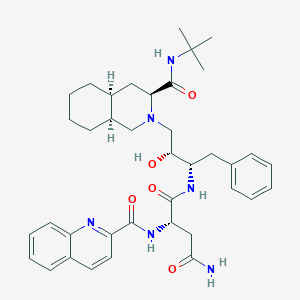HIV infection
Adult: In combination w/ other antiretrovirals: 1,000 mg bid w/ ritonavir 100 mg bid. Treatment-naive patients: 500 mg bid (w/ ritonavir 100 mg bid) for the 1st 7 days of treatment then increase to 1,000 mg bid.
|
Indications and Dosage
Oral
HIV infection Adult: In combination w/ other antiretrovirals: 1,000 mg bid w/ ritonavir 100 mg bid. Treatment-naive patients: 500 mg bid (w/ ritonavir 100 mg bid) for the 1st 7 days of treatment then increase to 1,000 mg bid.
|
|
Administration
Should be taken with food. Take w/ meals or up to 2 hr after meals.
|
|
Contraindications
Hypersensitivity. Congenital or documented acquired QT prolongation, complete AV block (including patients at high risk) w/o implanted pacemakers, electrolyte disturbance (particularly uncorrected hypokalaemia), clinically relevant bradycardia or heart failure w/ reduced left-ventricular ejection fraction, history of symptomatic arrhythmia. Severe hepatic impairment. Lactation. Concomitant admin w/ drugs that prolong QT or PR interval, sedative/hypnotics (triazolam, oral midazolam), HMG-CoA reductase inhibitors (simvastatin, lovastatin), ergot alkaloids, rifampicin, quetiapine, alfuzosin.
|
|
Special Precautions
Patient w/ haemophilia A and B, pre-existing conduction system abnormalities. Mild to moderate hepatic or severe renal impairment. Pregnancy.
|
|
Adverse Reactions
GI disorders (e.g. abdominal pain, nausea, vomiting, flatulence, diarrhoea), fatigue, anaemia, alopecia, anorexia, increased appetite, asthenia, constipation, dizziness; dry lips, mouth and skin; dyspnoea, dyspepsia, eczema, headache, decreased libido, muscle spasm, malaise, peripheral neuropathy, paraesthesia, rash, pruritus, sleep disturbances, taste disorders; increased liver enzyme, blood amylase, bilirubin and creatinine levels; reduced Hb, platelet, lymphocyte and WBC counts; immune reconstitution syndrome, accumulation or redistribution of body fat, metabolic abnormalities (e.g. hypertriglyceridaemia), osteonecrosis. Abscess, angina tonsillaris, candidiasis, cellulitis, herpes simplex, herpes zoster, bacterial or mycotic infections, influenza, moniliasis. Rarely, acute myeloid leukaemia, allergic reactions, ascites, bullous skin eruptions, intestinal obstruction, jaundice, portal HTN, seizures, polyarthritis, attempted suicide.
Potentially Fatal: Hypersensitivity (e.g. anaphylactic reaction, Stevens-Johnson syndrome), thrombocytopenia, haemolytic anaemia, pancreatitis, nephrolithiasis. |
|
Monitoring Parameters
Monitor ECG, serum K and Mg levels, triglycerides, cholesterol, viral load, CD4 count and glucose.
|
|
Overdosage
Symptoms: Fatigue, general weakness, diarrhoea, nausea, vomiting, hair loss, dry mouth, wt loss, hyponatraemia, orthostatic hypotension. Management: Supportive treatment.
|
|
Drug Interactions
May increase plasma concentration of fusidic acid. Increased risk of bleeding w/ anticoagulants
(e.g. rivaroxaban). May alter plasma concentrations of warfarin.
Potentially Fatal: Potentially prolonged or increased sedation and resp depression w/ sedative/hypnotics (oral midazolam, triazolam). Increased risk of myopathy including rhabdomyolysis w/ HMG-CoA reductase inhibitors (simvastatin, lovastatin). Increased potential for acute ergot toxicity w/ ergot alkaloids (e.g. ergotamine, dihydroergotamine, ergonovine, methylergonovine). Increased risk of severe hepatotoxicity w/ rifampicin. Risk of coma w/ quetiapine. Risk of hypotension w/ alfuzosin. Additive effect on QT or PR interval prolongation w/ antiarrhythmics (amiodarone, bepridil, dofetilide, flecainide, systemic lidocaine, propafenone, quinidine) neuroleptics (e.g. pimozide, clozapine, haloperidol), sildenafil (if used for pulmonary arterial HTN), antidepressant (trazodone), some anti-infectives (clarithromycin, erythromycin, halofantrine, pentamidine), some antihistamines (terfenadine, astemizole). |
|
Food Interaction
Increased absorption w/ high-fat meal. Reduced concentration w/ St John’s wort and garlic. Increased serum levels w/ grapefruit juice.
|
|
Action
Description: Saquinavir is a selective, competitive, reversible HIV protease inhibitor that interferes w/ the formation of essential proteins and enzymes. It blocks virus maturation and causes non-functional, immature and non-infectious virions formation.
Pharmacokinetics: Absorption: Incompletely absorbed from the GI tract. Increased absorption w/ high-fat meal. Bioavailability: 4%. Distribution: Extensively distributed into tissues. Volume of distribution: 700 L. Plasma protein binding: Approx 98%. Metabolism: Rapidly metabolised to several inactive monohydroxylated and dihydroxylated compounds by CYP3A4 isoenzyme. Undergoes extensive first-pass hepatic metabolism. Excretion: Mainly via faeces. Terminal elimination half-life: 13.2 hr. |
|
Chemical Structure
 Source: National Center for Biotechnology Information. PubChem Database. Saquinavir, CID=441243, https://pubchem.ncbi.nlm.nih.gov/compound/Saquinavir (accessed on Jan. 23, 2020) |
|
Storage
Store at 25°C.
|
|
MIMS Class
|
|
ATC Classification
J05AE01 - saquinavir ; Belongs to the class of protease inhibitors. Used in the systemic treatment of viral infections.
|
|
References
Anon. Saquinavir mesylate. AHFS Clinical Drug Information [online]. Bethesda, MD. American Society of Health-System Pharmacists, Inc. https://www.ahfscdi.com. Accessed 17/02/2016. Anon. Saquinavir. Lexicomp Online. Hudson, Ohio. Wolters Kluwer Clinical Drug Information, Inc. https://online.lexi.com. Accessed 17/02/2016. Buckingham R (ed). Saquinavir. Martindale: The Complete Drug Reference [online]. London. Pharmaceutical Press. https://www.medicinescomplete.com. Accessed 17/02/2016. Invirase (saquinavir mesylate) capsules and tablets. U.S. FDA. https://www.fda.gov/. Accessed 17/02/2016. Invirase Capsule and Tablet, Film-coated (Genentech, Inc.). DailyMed. Source: U.S. National Library of Medicine. https://dailymed.nlm.nih.gov/dailymed/. Accessed 17/02/2016. Joint Formulary Committee. Saquinavir. British National Formulary [online]. London. BMJ Group and Pharmaceutical Press. https://www.medicinescomplete.com. Accessed 17/02/2016.
|